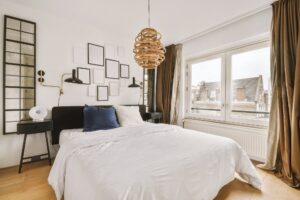The study of how various colors can impact behavior, emotions, and mood in people is known as color psychology. Individuals can experience distinct emotions and reactions to different colors, each of which possesses distinct psychological properties. Red, for instance, is frequently connected to vigor, passion, and excitement, whereas blue is connected to peace, tranquility, and trust. If you want to create the right ambiance & atmosphere in each room of your house, it is crucial to understand the psychology of color when selecting paint colors.
Key Takeaways
- Color can have a significant impact on our emotions and behavior, so it’s important to understand the psychology of color when choosing paint for a room.
- When choosing the right color for each room, consider the function of the space and the mood you want to create. For example, calming blues and greens are great for bedrooms, while energizing yellows and oranges work well in kitchens and dining areas.
- To create a cohesive color scheme, consider using a color wheel to find complementary or analogous colors that work well together. You can also use different shades of the same color for a monochromatic scheme.
- Exploring different finishes and textures can add depth and interest to a room. Consider using matte, satin, or glossy finishes, as well as textured paints or wallpapers.
- Using accent colors can add visual interest and personality to a room. Consider adding pops of color through accessories, furniture, or a feature wall.
- When choosing paint colors, consider the lighting and size of the room. Dark colors can make a small room feel even smaller, while natural light can affect how a color appears.
- It’s important to test paint samples in the actual room before making a final decision, as lighting and other factors can affect how the color looks.
Moreover, people’s perceptions of a space can be influenced by color psychology. While cool colors like blue, green, and purple can create a sense of spaciousness and tranquility, warm colors like red, orange, and yellow can make a space feel cozier and more intimate. Through an understanding of the psychological implications of color, you can strategically employ color to improve the mood and functionality of every room in your house. The purpose of the room and the mood you want to create should be taken into account when selecting the ideal color for each room in your house.
For instance, to encourage relaxation and sound sleep, you might want to use soothing colors in the bedroom, such as gentle blues, greens, or lavender. Conversely, to create a vibrant and welcoming atmosphere in the kitchen, you may choose to use energetic and appetite-stimulating colors like reds, oranges, or yellows. When choosing paint colors for any room, it’s also imperative to consider the natural light in that space. Brighter and lighter colors can help a room feel more spacious and airy, while darker and bolder colors work better in rooms with less natural light. You can also choose a color that accentuates the overall aesthetic & style of the space by taking into account the furniture and décor that are currently in each room.
A well-balanced color scheme that flows naturally from room to room is essential to creating a unified look throughout your house. One strategy is to paint the entire house a base color that is neutral, like a soft beige or gray, and then add accent colors to each room to give it some individuality & variation. By allowing for individuality in each space, this can help establish a sense of harmony and continuity. Taking into account the color undertones of your selections is another way to create a color scheme that flows. For instance, you should choose accent colors with complementary warm undertones if you decide to use warm beige as your neutral base color.
Also, mixing and matching hues of the same color within separate rooms can add depth and interest to the overall design while producing a unified and harmonious look. Examining various finishes and textures can improve each room’s visual appeal in addition to selecting the appropriate colors for your house. A space’s overall aesthetic can be enhanced & varied effects can be produced by using different paint finishes, such as gloss, satin, eggshell, and matte. For instance, a matte finish on the walls can produce a more muted and understated look, while a high-gloss finish on the trim and molding can add a touch of elegance and sophistication.
Incorporating textured finishes, such as Venetian plaster, stucco, or faux finishes, can also give walls more depth and visual interest by adding dimension. Also useful for hiding wall flaws, textured finishes give each room a special, customized appearance. Your house can have a more stylish look and a more lively, engaging atmosphere by experimenting with different finishes and textures. The ability to add visual interest, establish focal points, and unify disparate elements in a space make accent colors essential to interior design. Selecting hues that go well with the primary color palette is crucial when picking accent colors, as it affects the entire color scheme of the room.
Softer accent colors can be utilized to establish harmony and balance, while bolder accent colors can be used sparingly to highlight particular architectural features or decorative elements. Using accent colors in accessories such as rugs, throw pillows, artwork, & decorative objects can also make future adjustments flexible and simple. With this method, you can try out various accent colors without having to settle on a wall color change that will last forever.
A unified and well-coordinated aesthetic throughout your house can also be achieved by carefully selecting accent colors. Considerations such as lighting and room dimensions should be made when selecting paint colors for your house. A room’s perception of paint colors can be greatly affected by natural light, which can either intensify or dull particular colors. While rooms with limited natural light may benefit from lighter colors to make the space feel more open and airy, rooms with ample natural light can handle darker colors without feeling claustrophobic or overwhelming. The best paint colors for a room also depend on its size. Lighter colors can give the impression of more space and make a smaller space feel bigger and more expansive.
Darker hues, on the other hand, can make larger rooms feel cozier & cozier without appearing overwhelmingly large. You may maximize each room’s visual impact & create a welcoming and cozy living space by choosing paint colors that take lighting & room size into account. Take note of how paint samples appear in each room under various lighting conditions throughout the day before deciding on a paint color for your house. You can make an informed choice by testing paint samples on different walls because different paint colors appear differently in natural light, artificial light, & different times of day. Also, you can get a better idea of how the overall color scheme will work by seeing how paint samples interact with the existing flooring, furniture, and décor.
It is advised to apply paint samples on spaces that are sufficiently large (at least 2 feet by 2 feet) in order to properly evaluate how they look. This lets you see the color’s appearance in the space from various viewpoints & distances. It’s crucial to pay attention to how the paint color blends with other design elements in the room and whether it creates the intended atmosphere and mood. Before making a final choice, take the time to test paint samples to make sure the colors you’ve selected will improve the overall appearance of your house.
Looking to revamp your home decor? In addition to choosing the perfect interior paint colors, consider investing in high-quality furniture to elevate your space. Check out this insightful article on why people love Clayton Marcus furniture to discover how you can add timeless elegance and comfort to your home. Pairing the right paint colors with stylish and durable furniture can truly transform any room.
FAQs
What are some popular interior paint colors?
Some popular interior paint colors include neutral tones such as white, beige, and gray, as well as bolder choices like navy blue, emerald green, and blush pink.
How do I choose the right interior paint color for my space?
When choosing an interior paint color, consider the mood you want to create, the natural light in the room, and the existing furniture and decor. It can also be helpful to test paint samples on the walls to see how they look in different lighting.
What are some tips for coordinating interior paint colors throughout a home?
To coordinate interior paint colors throughout a home, consider using a consistent color palette or choosing colors that complement each other. You can also use accent colors to tie different rooms together.
What are some trending interior paint colors for this year?
Trending interior paint colors for this year include warm earthy tones like terracotta and ochre, as well as calming shades of blue and green. Additionally, muted pastels and bold jewel tones are popular choices.
Are there any rules for using different paint colors in different rooms?
There are no strict rules for using different paint colors in different rooms, but it’s important to consider how the colors will flow together and whether they create the desired atmosphere for each space. It can be helpful to use a cohesive color scheme or to incorporate complementary colors.





